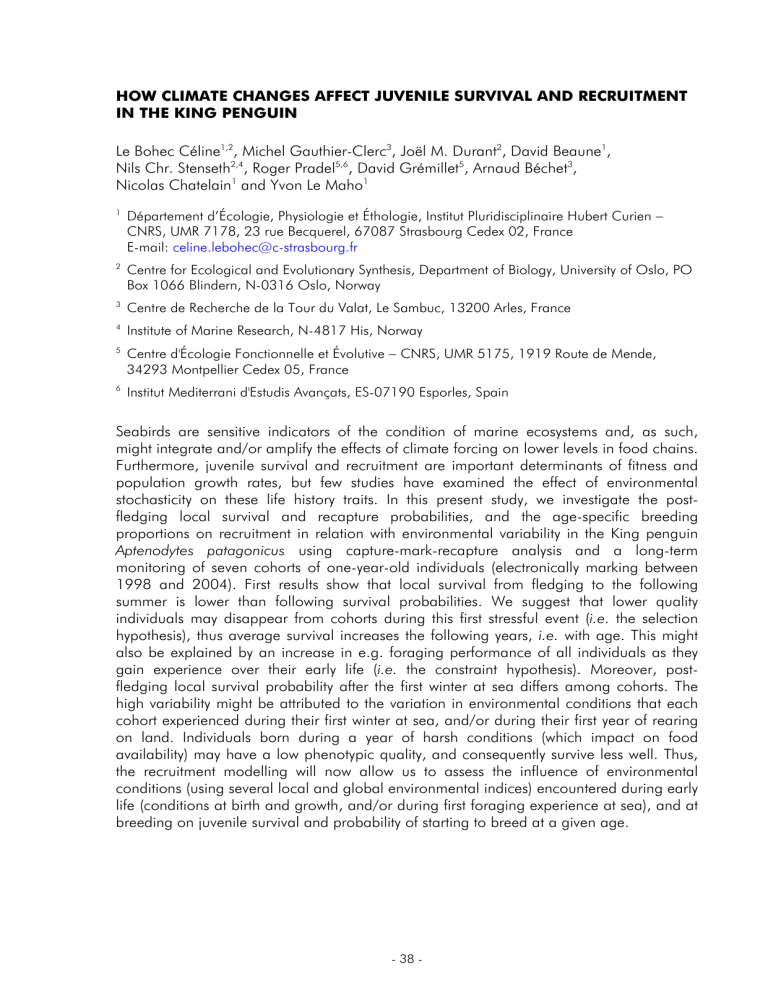HOW CLIMATE CHANGES AFFECT JUVENILE SURVIVAL AND RECRUITMENT Le Bohec Céline

HOW CLIMATE CHANGES AFFECT JUVENILE SURVIVAL AND RECRUITMENT
IN THE KING PENGUIN
Le Bohec Céline 1,2
Nils Chr. Stenseth 2,4
Nicolas Chatelain 1
, Michel Gauthier-Clerc
, Roger Pradel 5,6
and Yvon Le Maho 1
3 , Joël M. Durant
, David Grémillet 5
2 , David Beaune
, Arnaud Béchet 3 ,
1 ,
1 Département d’Écologie, Physiologie et Éthologie, Institut Pluridisciplinaire Hubert Curien −
CNRS, UMR 7178, 23 rue Becquerel, 67087 Strasbourg Cedex 02, France
E-mail: celine.lebohec@c-strasbourg.fr
2 Centre for Ecological and Evolutionary Synthesis, Department of Biology, University of Oslo, PO
Box 1066 Blindern, N-0316 Oslo, Norway
3 Centre de Recherche de la Tour du Valat, Le Sambuc, 13200 Arles, France
4 Institute of Marine Research, N-4817 His, Norway
5 Centre d'Écologie Fonctionnelle et Évolutive − CNRS, UMR 5175, 1919 Route de Mende,
34293 Montpellier Cedex 05, France
6 Institut Mediterrani d'Estudis Avançats, ES-07190 Esporles, Spain
Seabirds are sensitive indicators of the condition of marine ecosystems and, as such, might integrate and/or amplify the effects of climate forcing on lower levels in food chains.
Furthermore, juvenile survival and recruitment are important determinants of fitness and population growth rates, but few studies have examined the effect of environmental stochasticity on these life history traits. In this present study, we investigate the postfledging local survival and recapture probabilities, and the age-specific breeding proportions on recruitment in relation with environmental variability in the King penguin
Aptenodytes patagonicus using capture-mark-recapture analysis and a long-term monitoring of seven cohorts of one-year-old individuals (electronically marking between
1998 and 2004). First results show that local survival from fledging to the following summer is lower than following survival probabilities. We suggest that lower quality individuals may disappear from cohorts during this first stressful event ( i.e. the selection hypothesis), thus average survival increases the following years, i.e.
with age. This might also be explained by an increase in e.g. foraging performance of all individuals as they gain experience over their early life ( i.e. the constraint hypothesis). Moreover, postfledging local survival probability after the first winter at sea differs among cohorts. The high variability might be attributed to the variation in environmental conditions that each cohort experienced during their first winter at sea, and/or during their first year of rearing on land. Individuals born during a year of harsh conditions (which impact on food availability) may have a low phenotypic quality, and consequently survive less well. Thus, the recruitment modelling will now allow us to assess the influence of environmental conditions (using several local and global environmental indices) encountered during early life (conditions at birth and growth, and/or during first foraging experience at sea), and at breeding on juvenile survival and probability of starting to breed at a given age.
- 38 -







